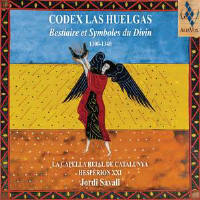Text posted on the website of: |
|
|
THE BESTIARY AND DIVINE SYMBOLS Monastery of Santa María la Real de Las Huelgas (Burgos)
The forest of mysticism is not easily penetrated. There are no beaten paths. The last veil of reality cannot be lifted. Mysticism watches and reveals.
Raimon Panikkar
In the monastic life of the Cistercian order, as in the case of the female monastery of Santa María la Real de Las Huelgas (Burgos), a royal pantheon, the seat of coronations and the epicentre of a very intense musical life in which singing played an extremely important part, the nuns were called upon to live a life of simplicity, silence, prayer and contemplation. Flavit auster, which is part of the Las Huelgas Codex, is a Marian text inspired in the Song of Songs in which the most powerful symbols of femininity appear, such as the honeycomb, milk and honey, and protectiveness described as “mother of mercy, port of hope for the shipwrecked and virgin mother purified.” We also find these symbols as early as the 9th century in Islamic and Jewish spirituality where we are taught the nature of the journey within, a path of challenges, knowledge, of the soul’s encounter and union with God. As St Teresa writes, “see this shining castle and this beautiful Oriental pearl, this tree of life which is planted in the very living waters of life.”
Along with this fascinating symbolism of the Queen of Heaven radiant with light among the stars, the golden star, the sun and the moon, as well as the image of milk and honey, flowers, the jewels of Spring, roses, violets, saffron and laurel, in the Las Huelgas Codex we find many animal symbols of Christ, as they were present at the dawn of Christianity. Let us remember the lambs, doves and fish depicted in the frescoes of the early Christian catacombs and Byzantine mosaics. The reality of this world is at once both mystically reflected and veiled. The roots of Christianity are to be found in Platonic teaching, and it was in this philosophical context, which in turn drew on Egyptian and Hindu wisdom, that the new faith was born.
The earliest known Christian bestiary, the Physiologus, was probably written in the 3rd century in Syria. This fundamental text fed the imagination of generations of artists and theologians. The Hispanic Ars antiqua has preserved many works in which animals are allegories of faith which merge with the two- or four-legged companions of medieval man. Alongside basic Marian symbols such as the eagle, the lamb, the fish and, of course, the dove, we find other more surprising creatures such as the “abominable” flies, which traditionally accompany the Prince of Darkness, but also the pelican, a symbol of Christ’s sacrifice, or the dragon, which represented the guardian of the frontiers of the known world. This flame-spitting monster was initially an image of vigilance and ardour before being slain by St George and Siegfried.
It is also in this Codex that we find (in the faux-bourdons of Notre Dame of Paris, and in the pilgrim songs of the Llibre Vermell of Montserrat), the earliest multi-voice songs, the faux-bourdons and the first musical experiments with independent melodies simultaneously sung together. It was the beginning of a true revolution, the Ars nova, which gave rise to a new musical language and which would be masterfully developed by great composers such as Philippe de Vitry and Guillaume de Machaut. At the very moment when national languages were asserting themselves, Ars nova marks the moment at which music became Europe’s true common language.
JORDI SAVALL Konya, 23rd September, 2022
TRANSLATED BY JACQUELINE MINETT |
|




